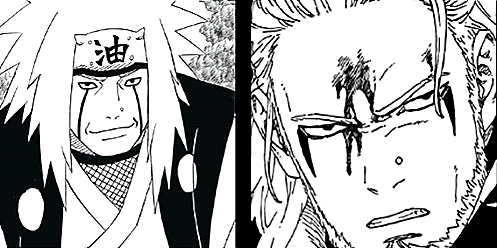Would the Real Koji Kashin Please Stand Up?
Exploring the narrative and folklore origins of Koji Kashin

What Boruto tells us about Koji Kashin is factual: he's a clone of the great Jiraiya created by Amado Sanzu with the express purpose of killing Otsutsuki. His villainous acts in part one of Boruto, from killing Ao in cold blood to engulfing Konohamaru in flames, were merely an extension of his mission to save the planet from assured destruction when Isshiki would feed Jigen into the Divine Tree and revive in Kawaki's body. In his return in Boruto: Two Blue Vortex, he reveals that his mission never ended even when his body was wrecked by battle. As he was preparing to die, the dormant Shibai cells implanted in him by Amado suddenly awoke, imbuing him with Prescience and allowing him to see a myriad of futures in which the Divine Tree's threat to the planet continued on in the form of sentient Shinju.
Beyond this, we know nothing about Koji's life, his moral compass, his perception of self, his greater goals.
Is he content to be a tool of Amado's, stubbornly adhering to the mission he was created to fulfill? Is he truly the platonic ideal of a Shinobi, a man living for that mission and wanting nothing else? Does he harbor resentment toward Amado for setting him up to destroy Jigen's body, then die at the hands of Isshiki? Does he have an ulterior motive for existing? When he offers to ally himself with Boruto, is he serving Boruto's agenda, or is Boruto another tool for him to manipulate for the purposes of his own mission?
Who really is Koji Kashin?
A Clone
Boruto explores themes of memory, identity, and humanity through the characters created by cloning in the series. Mitsuki, Delta, Koji, and even, to some extent, the Shinju themselves, are artificial beings, replicated versions of an original individual. And yet, none of these characters share direct traits with the progenitor of their genetic material.
This is most notable in Delta, the clone of Amado's deceased daughter. She's a perfect reproduction of Akebi's body and contains all her memories. Yet, time and again, Amado has tried to replicate the child he lost and fails. Despite the physical form and memories, Delta's individual identity asserts itself over who Akebi once was, a hint that human existence is more than just memories and genetics. We only learn about Delta though Amado's exposition rather than the character herself, so we lack insight as to how her experience of living in a dead woman's body and sharing her past shaped her personality. The bitterness and loathing she demonstrates toward Amado could be a result of having Akebi's memories, a daughter abandoned by her father on her deathbed as he pursued a solution or his grief instead of providing for her comfort.
In contrast to Delta, created to revive a lost child, we have Mitsuki, a clone who was created to make Orochimaru a parent. Whereas Amado is dedicated to creating a clone who becomes exactly what he desires, Orochimaru wanted his child to have free will and erased Mitsuki's memories and experimented on him until he proved that he was capable of choosing his own path. Despite this, we see Mitsuki questioning his own humanity, feeling as though he needs a sun to illuminate the darkness of his moon and guide him. He also discounts his own ability to be fully human, telling Delta he would not have experienced the splendid emotion of love had her Charm powers not affected him. But by being affected, he's proven he's as human as all the other beings on the planet, a true human overcome by her spell, and probably as capable of feeling love as anyone, had he only believed in his ability to do so.
When it comes to Koji, we're unsure how much he relates to Jiraiya (or how Amado managed to obtain any of Jiraiya's DNA when his body is at the bottom of an ocean). Like Delta, does he share Jiraiya's memories, or is it knowledge of Jiraiya that inspires him to follow the Shinobi way?
As readers of Naruto, we're aware of Jiraiya's human failings: his womanizing, drinking, gambling. He was an imperfect human, but, in the end, a perfect shinobi who sacrificed himself not only for the village, but for the belief that his student could free the world of cyclical hatred.
Like Delta and Akebi, we see that Koji lacks Jiraiya's personality and traits, both his flaws and the things that made him lovable and human. Whereas Jiraiya was often distracted by vices, Koji's life seems almost monastic, devoid of joy and pleasure.
Men of Folklore
In the Naruto universe, names are often laden with meaning. Both Jiraiya and Koji Kashin were plucked from Japanese folktales, though Jiraiya's origins are more mythical while Koji Kashin, whether real or not, has his story centered in Japanese history.
There are varying stories about Jiraiya the Gallant, the son of a murdered lord who became a murderer and thief himself before being given a second chance to use his larcenous ways to rob from the rich and protect the poor with the addition of toad magic. The Chinese story, its hero not dissimilar to England's Robin Hood, started sometime between the 10th and 13th centuries before gaining popularity in Japan. The most common version of the story, first published in the early 19th century, is the one most Naruto readers would be familiar with, containing the maiden Tsunade with her slug magic and the evil Orochimaru with his snake magic.
Compared to Jiraiya the Gallant, Koji Kashin's story seems more quaint: He was a monk kicked out of a monastery for using forbidden magic. Whereas Jiraiya's acts were fantastical, Koji's magic favored trickery and, according to modern-day magicians, were simple acts of illusion that real magicians are capable of performing. Instead of being surrounded by a cast of equally fictional characters, the stories of Koji's life had him interacting with true historical figures in positions of power throughout the 16th century, often proving them to be cowards or fools.
Knowing that Jiraiya is the original specimen and Koji the clone, it seems notable that Koji is closer to being a real historical figure, his stories told in gossip books of the era, while Jiraiya is the wholly fictional character. This leaves open the possibility that the question of how Amado got Jiraiya's DNA could be solved by Koji being the original person and Jiraiya the second iteration.
What also seems notable about the differences in the stories between the men is that while both are rogues to some extent or another, Jiraiya is actually a heroic figure while Koji is nothing more than a trickster at best, a conman at worst, throughout his whole life. While both are figures who push back against authority, Jiraiya ends up fighting noble battles while Koji runs for his life.
Due to Koji's Prescience, the ability to see a plethora of futures and nudge fate in a particular direction by affecting events as they occur, it's worth taking a deeper dive into the specifics of some of his abilities.
Some of Koji's tricks were simple, such as turning leaves into fish or making a skeptic's tooth appear loose, while others were more involved, uncovering the secrets of powerful men and embarrassing them before fleeing. However, one of the most interesting stories involves a time during which Koji was making his living by giving religious lectures and selling scrolls that depicted Buddhist hell. One of his scrolls was so intricate that a wealthy lord thought he could truly see the images moving and hear the screams of the people trapped in it. When he offered Koji a price, Koji said he couldn't sell it because it was priceless. Eventually forced into a corner by threats, Koji agreed to sell it, and immediately after, the images ceased moving. When the lord confronted Koji about the change, he said that selling the scroll had put a price on it, making it no longer priceless and, thus, rendering it inert.
What's interesting about this story is that it can be related to the way Koji sees the future through moving images, and the only futures he's shared with us so far end in the world turning into a type of hell. While I can't claim to have any in depth expertise in Buddhism, hell is a place people who lived temporarily wicked lives go to and suffer their own mental torture until their bad karma is depleted and they can be reborn yet again in the material world. This poses the possibility that Koji is a rebirth of Jiraiya, suffering for his depraved life on earth, or that Koji's visions are being used to manipulate someone else with images of hell.
Whether Koji Kashin was a real person or a tall tale meant to poke fun at the failings of powerful people, he remains a trickster and illusionist in every story, which should make us cautious to outright trust his motivations and the "magic" he manifests through Prescience.
The question we should be asking is: Who is he tricking?
We know Koji misled Jigen, the character in the series who is arguably the closest to the figure of a corrupt lord, but does his deceit end there? During his first meeting with Boruto in Boruto: Two Blue Vortex, we can read the conversation he has as an honest exchange, or we can read the subtle ways he nudges Boruto in the direction he wants to him to go, first invoking his identity as a shinobi on a mission to justify his earlier behavior, the dangling expanded powers and the chance to free Boruto's master, Sasuke, if only Boruto would agree to work with him.
Likewise, only Koji knows he endings of each possible future he can see, and though he tells Boruto (and others) that he's guiding them to a future in which Shinju don't destroy the planet, it's possible he has another future in mind which fulfills his own, yet unknown, desires.
The Boruto narrative, both in the anime and the manga, has been deliberate about not revealing Koji's inner thoughts, his past, or his future goals. As the plot continues to unfurl, his character is primed for additional seismic reveals beyond what we've already learned about Prescience.
